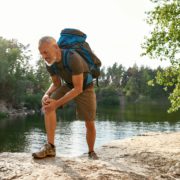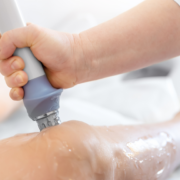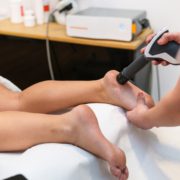Love to Hike? 7 Strategies for Healthy Knees
Love to Hike? 7 Strategies for Healthy Knees
Hiking isn’t just good for the soul – it’s one of the best forms of exercise for longevity. Long, steady hikes typically put you in Zone 2 cardio, that sweet spot where your heart rate is elevated but you can still hold a conversation. Research shows Zone 2 training is one of the most powerful ways to build endurance, improve metabolic health, and protect your heart as you age. When you combine that with fresh air, nature, and the mental reset that hiking provides, you’ve got a recipe for living longer and healthier.
But here’s the catch…
If your knees hurt, you’re far less likely to get out on the trails and enjoy those benefits. For many adults in their 40s, 50s, and beyond, it’s knee pain – not lack of motivation – that sidelines them. Personally, I love to hike. My pup Bodie and I have already tackled 33 of the 48 White Mountain 4,000-footers together – and the last thing I want is for knee pain to derail that journey. Over the years, both in the clinic and on the trails, I’ve learned that protecting your knees isn’t just about avoiding injury – it’s about building mobility, balance, and strength so you can keep hiking and keep hitting that Zone 2 target for decades.
Here are 7 of my top strategies to keep your knees healthy on the trails:
1. Strengthen More Than Just Your Legs
Most hikers know strong legs matter. But what often gets overlooked is the role of your hips and core. Your glutes and hip muscles stabilize your pelvis, which in turn keeps your thigh bone – and your knee – aligned. If these areas are weak, your knee takes the brunt of every single step. On a typical 4K-footer, I rack up around 27,000 steps. Imagine your knee compensating on each one. Prioritize exercises that target glutes, hip stabilizers, and core muscles. Think bridges, planks, side steps, and single-leg work. The stronger your foundation, the better your knees will perform under pressure.
2. Keep Your Knees (and Hips) Mobile
Lack of mobility in your knees and hips – even a subtle loss – can impact the way your knees function. Your knees should fully straighten, bend deeply, and even hyperextend a little. Without this range, your knees can’t absorb the demands of steep inclines, rock scrambles, or uneven terrain. But don’t just focus on your knees – your hips and ankles need to move freely too. When one joint stiffens, another (often your knee) has to compensate. If your knees feel achy, check to make sure stiffness isn’t the reason.
3. Optimize Your Balance
Uneven trails, water crossings, and rocky descents demand excellent balance. Without it, your knees may end up working overtime to stabilize you. You can improve balance by practicing single-leg activities, such as standing on one foot while brushing your teeth, then progressing to single-leg squats and step-downs. Dynamic drills like walking heel-to-toe on a line or using a balance pad to mimic trail conditions can also be effective.
4. Train Eccentric Strength (Downhill Prep)
Most people’s knees flare up going downhill, not uphill. That’s because downhill hiking demands eccentric strength – the ability of your quads and even hips to control your descent while resisting gravity. Exercises like slow step-downs, controlled squats, and reverse lunges train your body for this exact stress, protecting your knees from strain when descending steep terrain.
5. Don’t Neglect Recovery
It’s easy to focus only on training for the hike, but recovery is just as important for keeping knees healthy long-term. Muscles and connective tissues adapt and get stronger when you give them time to repair. Simple recovery practices like foam rolling, stretching, and staying hydrated and prioritizing sleep all help reduce inflammation and improve resilience for the next hike. And if your knees are particularly sensitive after a hike – regenerative treatments like shockwave therapy and EMTT can help your joints recover quickly and naturally.
6. Choose Footwear That Supports Your Mechanics
Footwear can make or break your knees on the trails. Poor support or worn-out soles force your knees to work harder with every step. Good shoes aren’t just about cushioning – they should work with the way you move and give you stability when the trail gets rough. Keep in mind that your feet often widen and swell as you hike, which can change how your shoes fit and affect your mechanics. Choosing shoes with enough room in the toe box and proper support for your arches can prevent your knees from picking up the slack. Don’t forget the basics either – replacing trail shoes regularly (every 300–500 miles) is just as important as any strengthening exercise.
7. Get Checked Before It’s Too Late
One of the most overlooked strategies for preventing knee pain is early intervention. If you notice stiffness, swelling, or pain that doesn’t improve with movement, it’s better to get evaluated sooner rather than later. The longer you push through, the more compensations build up – and the harder it is to fix. In the same way you wouldn’t wait for your car to break before servicing it – you don’t want to wait for your knees to fail before seeking help.
Knee pain doesn’t have to stop you.
Hiking is one of the simplest and most enjoyable ways to support your health. It builds strength and endurance, keeps your heart and lungs working efficiently, and connects you to nature. But none of those benefits matter if knee pain keeps you on the sidelines. By strengthening your hips and core, improving mobility, training balance and eccentric control, choosing the right footwear, recovering properly, and seeking help early if pain persists – you’ll give your knees the best chance to keep carrying you up (and down) the trails for years to come.









